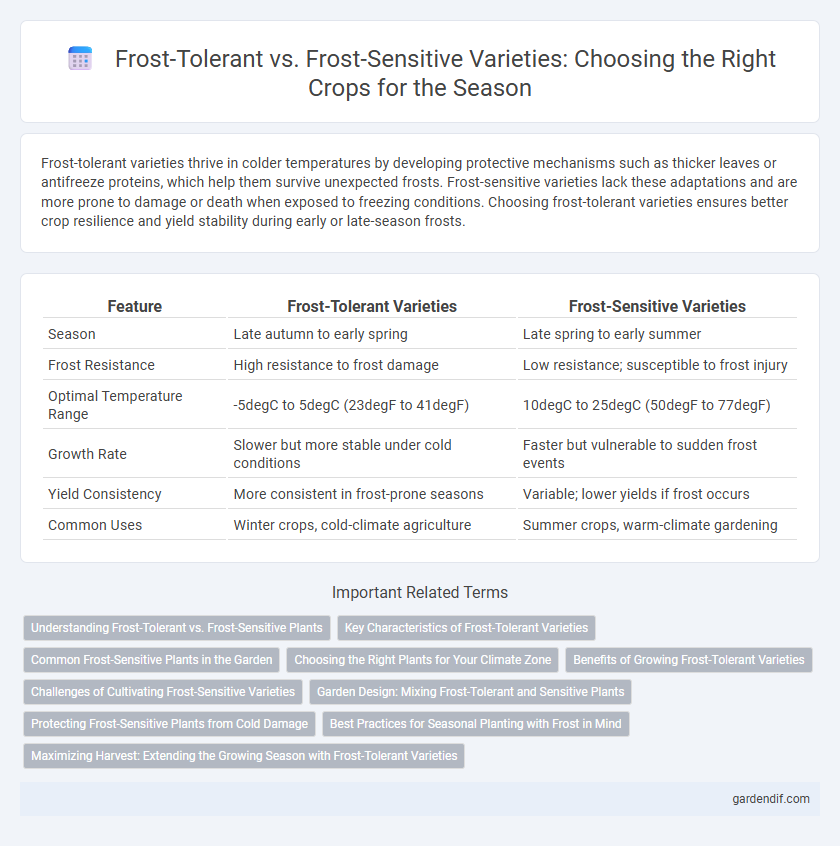
Frost-tolerant varieties vs Frost-sensitive varieties Illustration
Frost-tolerant varieties thrive in colder temperatures by developing protective mechanisms such as thicker leaves or antifreeze proteins, which help them survive unexpected frosts. Frost-sensitive varieties lack these adaptations and are more prone to damage or death when exposed to freezing conditions. Choosing frost-tolerant varieties ensures better crop resilience and yield stability during early or late-season frosts.
Table of Comparison
| Feature | Frost-Tolerant Varieties | Frost-Sensitive Varieties |
|---|---|---|
| Season | Late autumn to early spring | Late spring to early summer |
| Frost Resistance | High resistance to frost damage | Low resistance; susceptible to frost injury |
| Optimal Temperature Range | -5degC to 5degC (23degF to 41degF) | 10degC to 25degC (50degF to 77degF) |
| Growth Rate | Slower but more stable under cold conditions | Faster but vulnerable to sudden frost events |
| Yield Consistency | More consistent in frost-prone seasons | Variable; lower yields if frost occurs |
| Common Uses | Winter crops, cold-climate agriculture | Summer crops, warm-climate gardening |
Understanding Frost-Tolerant vs. Frost-Sensitive Plants
Frost-tolerant varieties possess cellular structures and antifreeze proteins that prevent ice crystal formation, allowing them to survive subzero temperatures and late spring frosts without significant damage. In contrast, frost-sensitive plants lack these adaptations, making their tissues vulnerable to freezing, which leads to cell rupture and impaired growth or death. Selecting frost-tolerant species is crucial for gardeners in cold climates to ensure plant survival and consistent seasonal yields.
Key Characteristics of Frost-Tolerant Varieties
Frost-tolerant varieties exhibit robust cellular structures that prevent ice crystal formation, enhancing survival during subzero temperatures. These plants often possess higher concentrations of antifreeze proteins and accumulate solutes like sugars to lower their freezing point. Their adaptive traits, such as thicker cuticles and altered leaf morphology, contribute to minimizing frost damage and sustaining growth in cold climates.
Common Frost-Sensitive Plants in the Garden
Common frost-sensitive plants in the garden include tomatoes, basil, cucumbers, and impatiens, which require protection or indoor relocation before frost events. These plants suffer cellular damage and slowed growth when exposed to temperatures below 32degF (0degC), resulting in wilting or death. Choosing frost-tolerant varieties like kale, pansies, and ornamental cabbages can extend the growing season and reduce the risk of frost damage.
Choosing the Right Plants for Your Climate Zone
Choosing frost-tolerant varieties such as kale, spinach, and pansies ensures plant survival and productivity in colder climate zones where temperatures frequently drop below freezing. Frost-sensitive plants like tomatoes, peppers, and petunias require warmer conditions and protection from frost to prevent damage and promote growth. Understanding your USDA hardiness zone helps in selecting appropriate plants that match the local frost patterns for optimal garden success.
Benefits of Growing Frost-Tolerant Varieties
Frost-tolerant varieties thrive in colder climates by withstanding temperatures below freezing, reducing crop loss and extending the growing season. These varieties enable earlier planting and later harvesting, maximizing yield potential and enhancing food security. Their resilience decreases the need for protective measures, lowering labor and resource costs for farmers.
Challenges of Cultivating Frost-Sensitive Varieties
Frost-sensitive varieties face significant challenges in cultivation due to their vulnerability to low temperatures, which can result in tissue damage, reduced growth, and lower yields. These varieties require careful microclimate management, including frost protection measures such as wind machines, heaters, or frost cloths, increasing operational costs. Furthermore, unpredictable frost events can cause crop loss, making frost-sensitive varieties riskier and less reliable compared to frost-tolerant cultivars in cooler climates.
Garden Design: Mixing Frost-Tolerant and Sensitive Plants
In garden design, combining frost-tolerant varieties like pansies, hellebores, and ornamental cabbages with frost-sensitive plants such as impatiens, fuchsias, and begonias creates dynamic seasonal interest while protecting delicate species. Positioning frost-sensitive plants in sheltered microclimates, such as near south-facing walls or under tree canopies, reduces frost damage and promotes optimal growth alongside hardier varieties. Strategic layering and plant placement enable gardeners to extend the growing season and maintain visual appeal despite fluctuating temperatures.
Protecting Frost-Sensitive Plants from Cold Damage
Frost-sensitive varieties require proactive protection measures such as mulching, using frost cloths, or placing plants in sheltered locations to prevent cold damage during frost events. Implementing windbreaks and ensuring adequate soil moisture can also help mitigate the impact of freezing temperatures on delicate plants. Monitoring weather forecasts allows for timely interventions that preserve plant health and promote seasonal growth.
Best Practices for Seasonal Planting with Frost in Mind
Choosing frost-tolerant varieties such as kale, spinach, and Brussels sprouts enables successful growth during late fall and early spring when frost is common. Planting frost-sensitive varieties like tomatoes, peppers, and basil after the last frost date reduces the risk of damage and ensures optimal development. Utilizing protective measures like row covers or cold frames further mitigates frost impact, extending the growing season for sensitive crops.
Maximizing Harvest: Extending the Growing Season with Frost-Tolerant Varieties
Frost-tolerant varieties enable farmers to extend the growing season by thriving in lower temperatures, allowing earlier planting and later harvesting periods compared to frost-sensitive varieties. These cultivars possess genetic adaptations that protect cellular structures from frost damage, resulting in improved crop resilience and yield stability during unpredictable cold snaps. Maximizing harvest through the selection of frost-tolerant seeds minimizes losses, enhances food security, and optimizes land use efficiency in regions susceptible to early or late-season frosts.
Frost-tolerant varieties vs Frost-sensitive varieties Infographic

 gardendif.com
gardendif.com